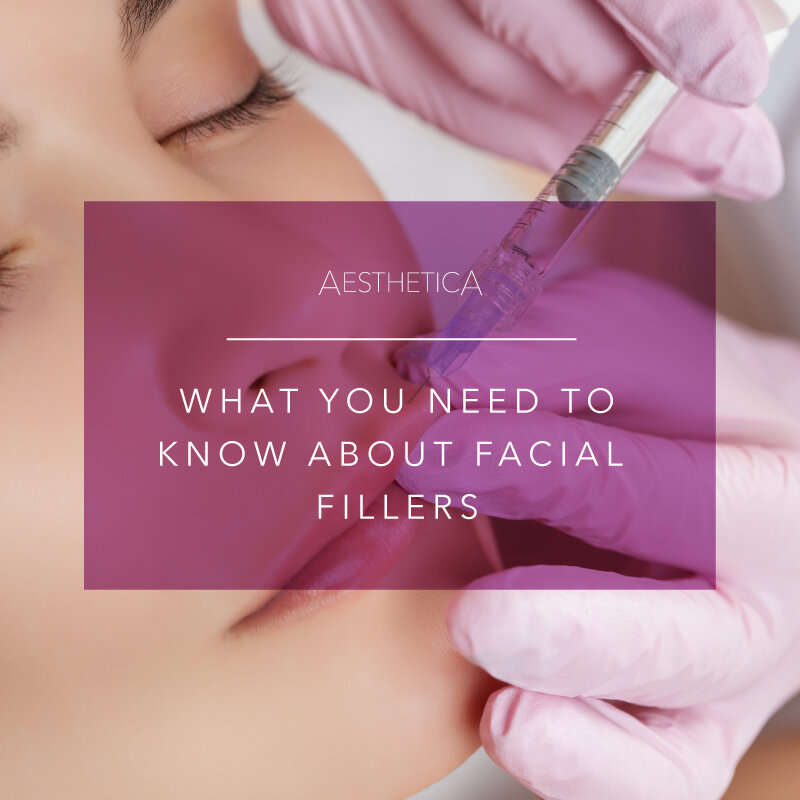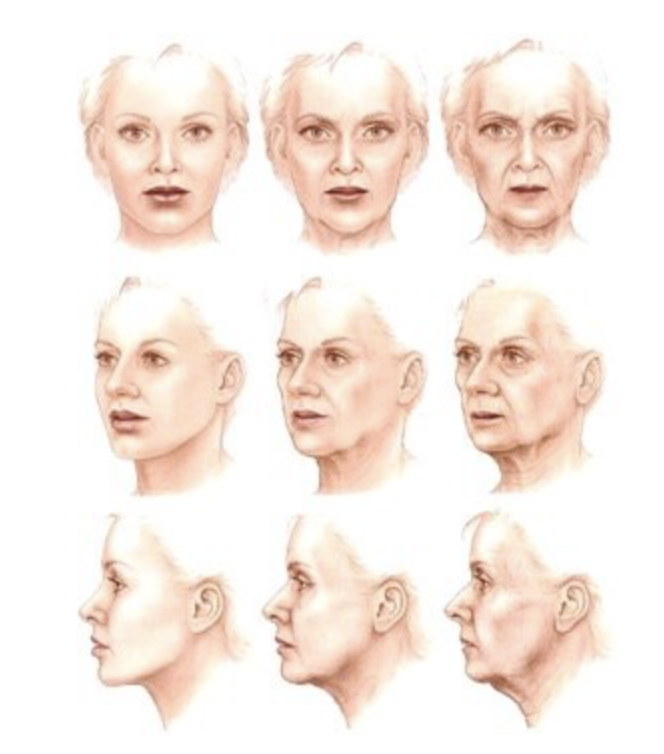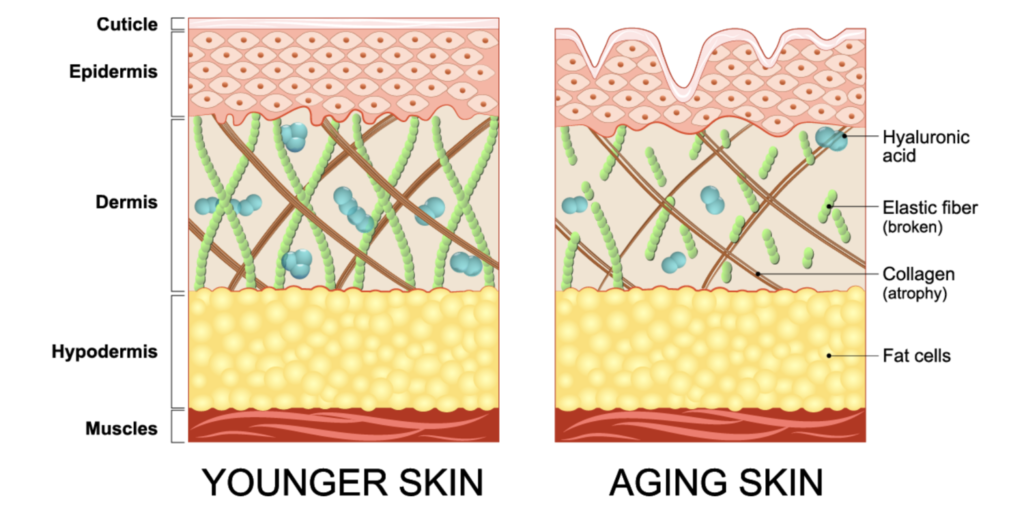
Facial aging is a fact of life for most. Individuals age at variable rates due to many factors including hydration, sun exposure, stress, sleep debt, nutrition, and social habits (i.e. alcohol and smoking). Some changes are more apparent than others:
Part of facial aging is redistribution of fat and water underneath the layers of our skin. During childhood and adolescence the upper parts of our head and face (i.e. temples and cheek bones) tend to have more fat and water underneath the skin. With time, the volume can redistribute to the lower parts of the face causing a more jowled like appearance. Additionally, the facial muscles have a tendency to weaken over time leading to saggy skin. The overall result of the aging process causes people to experience fine lines, wrinkles, and areas of volume loss (i.e. cheek bones, lips, nasal folds, areas around the lip). The cosmetics and pharmaceutical industries have been able to aid this process with the advent of creams, serums, and medical grade interventions to assist in rejuvenation modalities. Two approaches that medical providers have to help patients reach their aesthetic wellness goals include neuromodulators, more commonly known as Botox, and dermal fillers like Juvederm.
To understand how dermal fillers work it is imperative to know what their ingredients are and how they function to optimize the face. The following shows how the face ages:

Here we see a model in her 20’s (on left), in her 50’s (in the middle), and 70’s (on the right). The loss of facial volume is apparent. The result is downward movement of the facial soft tissues and a hollower look with the parenthesis lines around the nose.
With modern aesthetic technology, different dermal (skin) fillers have been developed to combat the aging face and hands. These include but are not limited to: Hyaluronic Acid (HA), Calcium Hydroxyapetite (CaHA), Poly-L-lactic Acid, and Polymethylmethacrylate (PMMA). The most commonly used substance is HA, as these fillers can be reversed with the enzyme hyaluronidase (Hylenex®).
HA molecules help bolster collagen molecules in the skin. It essentially helps maintain hydration and provide volume to skin. As fillers, HA is soft and gel like. Individual results vary, however patients can expect 6-12 months of time prior to the body absorbing the molecule. Manufacturers recognize that this procedure can be uncomfortable and have added lidocaine to the HA molecules to help with local anesthesia.

Common brands of HA filler include the Juvederm® family of fillers, Restylane® products, Revanesse Versa®, and Belotero®. Our practice currently offers both the Juvederm and Revanesse family of products. After a free consultation with one of our physician providers, patients will be offered the most appropriate choice of filler to achieve their rejuvenation goals.
Longer term solutions for facial rejuvenation may be better achieved using CaHA, Poly-L-lactic Acid, or even PMMA fillers. CaHA is present in each and every one of our bones. This can be synthetically created into a filler, which is generally thicker than HA and lasts on average about 1 year for most patients. One feature of CaHA fillers (i.e. Radiesse® family) is that it assists collagen production and is perhaps a more optimal choice for longer term volume loss intervention of deep lines and wrinkles.
Poly-L-lactic is a biodegradeable synthetic filler. The mechanism of action in this category is to stimulate collagen production. In contrast to other fillers, the gel substance only lasts for a few days. However, its effects can last longer than 2 years. Sculptra® Aesthetic is an FDA approved Poly-L-Lactic acid filler.
PMMA, like Poly-L-lactic acid filler, is a biosynthetic substance that has been used for over a century for different implant uses in medicine. With respect to dermal fillers, its microscopic architecture resembles a “microsphere” which remains beneath the skin, thereby providing it indefinite volume replacement. These fillers are accompanied by collagen which helps with structural integrity of skin, muscle, and facial connective tissue tautness. Bellafill® is the more commonly used PMMA filler.
https://www.health.harvard.edu/staying-healthy/why-your-face-ages-and-what-you-can-do
The Anatomy of the Aging Face: Volume Loss and Changes in 3-Dimensional Topography
Sydney R. Coleman, MD, Rajiv Grover, BSc, MB BS, MD, FRCS (Plast)
Aesthetic Surgery Journal, Volume 26, Issue 1_Supplement, January 2006, Pages S4–S9,https://doi.org/10.1016/j.asj.2005.09.012
Common brands of HA filler include the Juvederm® family of fillers, Restylane® products, Revanesse Versa®, and Belotero®. Our practice currently offers both the Juvederm and Revanesse family of products. After a free consultation with one of our physician providers, patients will be offered the most appropriate choice of filler to achieve their rejuvenation goals.
Longer term solutions for facial rejuvenation may be better achieved using CaHA, Poly-L-lactic Acid, or even PMMA fillers. CaHA is present in each and every one of our bones. This can be synthetically created into a filler, which is generally thicker than HA and lasts on average about 1 year for most patients. One feature of CaHA fillers (i.e. Radiesse® family) is that it assists collagen production and is perhaps a more optimal choice for longer term volume loss intervention of deep lines and wrinkles.
Poly-L-lactic is a biodegradeable synthetic filler. The mechanism of action in this category is to stimulate collagen production. In contrast to other fillers, the gel substance only lasts for a few days. However, its effects can last longer than 2 years. Sculptra® Aesthetic is an FDA approved Poly-L-Lactic acid filler.
PMMA, like Poly-L-lactic acid filler, is a biosynthetic substance that has been used for over a century for different implant uses in medicine. With respect to dermal fillers, its microscopic architecture resembles a “microsphere” which remains beneath the skin, thereby providing it indefinite volume replacement. These fillers are accompanied by collagen which helps with structural integrity of skin, muscle, and facial connective tissue tautness. Bellafill® is the more commonly used PMMA filler.
https://www.health.harvard.edu/staying-healthy/why-your-face-ages-and-what-you-can-do
The Anatomy of the Aging Face: Volume Loss and Changes in 3-Dimensional Topography
Sydney R. Coleman, MD, Rajiv Grover, BSc, MB BS, MD, FRCS (Plast)
Aesthetic Surgery Journal, Volume 26, Issue 1_Supplement, January 2006, Pages S4–S9,https://doi.org/10.1016/j.asj.2005.09.012